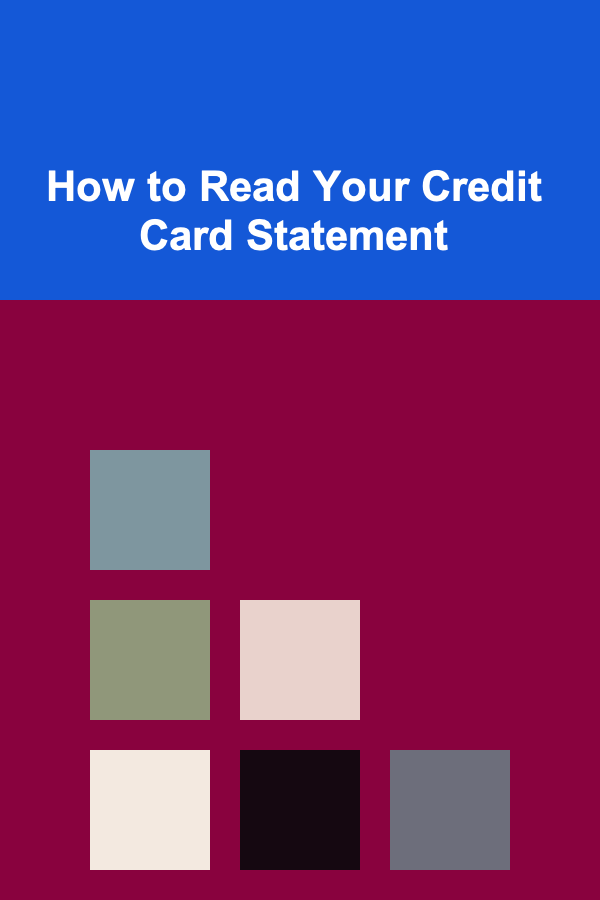
How to Read Your Credit Card Statement
ebook include PDF & Audio bundle (Micro Guide)
$12.99$9.99
Limited Time Offer! Order within the next:

Credit card statements are one of the most essential financial documents you will encounter. They give you a comprehensive view of your spending, help you keep track of your budget, and ensure that you pay your bills on time. However, for many people, reading a credit card statement can be confusing. In this article, we will break down how to read a credit card statement, highlighting the key sections and explaining how to understand each one.
A credit card statement typically arrives every month and provides a detailed summary of the transactions you've made with your credit card, your outstanding balance, and the payment due. By understanding how to interpret the information in your credit card statement, you can avoid late fees, minimize interest charges, and manage your finances effectively.
The Anatomy of a Credit Card Statement
A credit card statement is divided into several sections, each of which contains important information. Below is a breakdown of the main sections you'll typically find on a credit card statement.
1. Statement Date and Billing Cycle
At the top of your credit card statement, you will usually see the statement date and the billing cycle period. The statement date is the date when the statement is generated, and the billing cycle refers to the period during which the transactions on the statement were made. This period is typically one month long but may vary depending on the credit card issuer.
For example, if your statement date is the 15th of each month, your billing cycle may run from the 16th of the previous month to the 15th of the current month. Any purchases made after the statement date will appear on your next credit card statement.
2. Account Summary
The account summary section provides an overview of your credit card account for the current billing cycle. It includes several important details:
- Previous Balance: This is the amount you owed on your credit card at the end of the last billing cycle. It includes any outstanding balance carried over from previous months.
- Payments and Credits: Any payments you made during the current billing cycle will be listed here, along with any credits applied to your account.
- Purchases: This section summarizes the total amount of new purchases you made during the billing cycle.
- Cash Advances: If you used your credit card to withdraw cash, this will be listed in this section, along with any associated fees and interest.
- Fees and Interest: Any fees (e.g., late fees, annual fees) or interest charges that have been applied to your account during the billing cycle will appear here.
- New Balance: This is the total amount you owe on your credit card at the end of the current billing cycle, which includes the previous balance, new purchases, fees, and interest charges.
- Credit Limit: Your credit limit is the maximum amount you can charge to your credit card. This number is displayed in this section.
- Available Credit: This is the difference between your credit limit and your current balance. It shows how much more you can spend before reaching your credit limit.
3. Minimum Payment Due
This section is crucial because it tells you the minimum amount you must pay by the due date to avoid late fees and keep your account in good standing. The minimum payment due is typically a small percentage of your outstanding balance, often around 1% to 3%. However, paying only the minimum can lead to high interest charges, so it's a good idea to pay more than the minimum whenever possible.
4. Payment Due Date
The payment due date is the date by which your payment must be received to avoid late fees or interest charges. It is important to make sure your payment is made on time to avoid penalties. Some credit card issuers may offer a grace period, which is a certain number of days after the due date during which you can still make a payment without incurring fees, but it's always best to pay by the due date.
5. Transaction Detail
This is the most detailed part of your credit card statement and provides a breakdown of each individual transaction made during the billing cycle. Each transaction will include:
- Date: The date the transaction occurred.
- Description: This provides information about the merchant or service provider where you made the purchase. For example, it might list the name of the store or service and its location.
- Amount: The amount charged to your credit card for each transaction. This includes purchases, cash advances, and any fees associated with those transactions.
- Balance: Your balance after each transaction. This shows how your balance changes as a result of each purchase, payment, or fee.
6. Interest Charges
If you carry a balance on your credit card from one billing cycle to the next, interest charges will be applied. Credit card issuers typically charge interest on the outstanding balance at a rate called the APR (Annual Percentage Rate). This section will show the interest charges for the current billing cycle, broken down by the type of transaction (e.g., purchases, cash advances).
It's important to note that if you pay your full balance by the due date, you can often avoid interest charges entirely. Some credit cards offer an interest-free grace period on new purchases if the balance is paid in full.
7. Rewards Summary
If your credit card offers rewards points, cashback, or other benefits, this section will show you the rewards you've earned during the billing cycle. It will list:
- Rewards Earned: The amount of rewards points or cashback you've accumulated based on your purchases.
- Rewards Balance: Your total rewards balance, including points or cashback from previous billing cycles.
8. Fees
Credit card issuers often charge fees for certain services or behaviors. Common fees include:
- Annual Fee: Some credit cards charge a yearly fee for card membership.
- Late Payment Fee: If you fail to make the minimum payment by the due date, a late fee will be applied.
- Overlimit Fee: If you exceed your credit limit, you may be charged a fee.
- Foreign Transaction Fee: Some credit cards charge a fee for purchases made in a foreign currency or outside of the country.
This section will list any fees that have been applied to your account during the current billing cycle.
9. Credit Card Issuer's Contact Information
At the bottom of your statement, you will usually find the contact information for your credit card issuer, including the customer service phone number and website. If you have any questions or need to dispute a charge, this is where you can find the necessary contact details.
How to Analyze Your Credit Card Statement
Now that you know the structure of a credit card statement, here's how to analyze it effectively to ensure you are managing your finances responsibly.
Step 1: Review Your Transactions
Start by reviewing the transaction detail section. Look for any purchases that seem unfamiliar or unauthorized. If you spot a transaction you didn't make, it's important to report it to your credit card issuer immediately to dispute the charge and prevent fraud.
Step 2: Check Your Payment History
Ensure that your payments are being correctly recorded. If you made a payment that isn't reflected on your statement, reach out to your credit card issuer to confirm it was processed correctly.
Step 3: Evaluate Your Balance and Available Credit
Compare your new balance to your credit limit and available credit. If you are close to your credit limit, it's a good idea to make a payment before your next statement to avoid maxing out your card, which can negatively impact your credit score.
Step 4: Understand the Fees and Interest Charges
Take note of any fees that have been charged to your account, such as late fees or overlimit fees. Understanding why these fees were applied can help you avoid them in the future. Similarly, check your interest charges and understand how they're being calculated.
Step 5: Make Your Payment
Based on your current balance and the minimum payment due, decide how much you will pay. While paying the minimum payment is sufficient to avoid late fees, paying more than the minimum can help you reduce your balance more quickly and avoid interest charges.
Conclusion
Reading your credit card statement is a vital skill for managing your personal finances. By understanding the various sections of your statement, you can keep track of your spending, avoid unnecessary fees, and maintain a good credit score. Whether you're trying to pay off debt or just stay on top of your finances, regular review of your credit card statements is essential for staying financially healthy.

How to Choose the Right Wedding Venue for Your Needs
Read More
How to Maintain Your Home's Landscaping Year-Round
Read More
How to Manage Pet Hair Around the House Efficiently
Read More
How to Save for Retirement When You're Just Starting
Read More
How to Write a Compelling Donation Appeal Letter
Read More
How To Explore Synthetic Biology and Genetic Design
Read MoreOther Products

How to Choose the Right Wedding Venue for Your Needs
Read More
How to Maintain Your Home's Landscaping Year-Round
Read More
How to Manage Pet Hair Around the House Efficiently
Read More
How to Save for Retirement When You're Just Starting
Read More
How to Write a Compelling Donation Appeal Letter
Read More